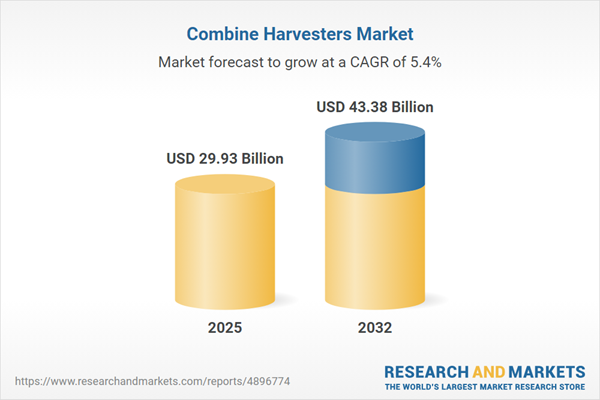Speak directly to the analyst to clarify any post sales queries you may have.
The global combine harvesters market is defined by swift technological advancement, shifting sustainability demands, and increasing supply chain complexity. Senior leaders are responding with innovative approaches to equipment investments and operational strategy as they position their organizations for long-term success in modern agriculture.
Market Snapshot: Combine Harvesters Market Overview
The combine harvesters market is experiencing strong growth amid a major shift toward digital connectivity and automation. Both mature and rapidly developing agricultural regions are deploying advanced technologies to optimize efficiency and minimize manual labor. This dynamic environment drives organizations to modernize their fleets with more versatile, durable machinery capable of addressing diverse cropping needs and field challenges. As a result, market participants are adopting fleet management solutions and updating operational processes to support continued adaptability and competitiveness. Evolving regulatory frameworks and rising customer expectations are also influencing how companies shape leadership and pursue resilient, future-focused strategies in this sector.
Scope & Segmentation: Strategic Insights for Leaders
This comprehensive report delivers practical segmentation analysis that empowers executive teams to identify improvement opportunities, plan sustainable investments, and foster growth in the global combine harvesters market.
- Types: Includes self-propelled and tractor-mounted models, enabling flexible deployment for agricultural operations ranging from smallholdings to large-scale agribusiness.
- Applications: Focuses on specialized harvesting solutions for corn, rice, soybean, and wheat, supporting tailored equipment adoption for varied crop and field conditions.
- Engine Power Levels: Offers a wide selection of horsepower ratings to ensure machinery suitability for distinct production needs and work intensities.
- Drive Types: Covers both two-wheel and four-wheel drive harvesters, increasing adaptability across multiple terrains and farming regions, and aiding in managing operational costs.
- Sales Channels: Encompasses OEM partnerships, aftermarket services, and digital distribution that enhance procurement, supply chain visibility, and asset management for buyers and suppliers alike.
- Regions: Addresses The Americas, Europe, Middle East and Africa, and Asia-Pacific, each presenting unique regulatory and agricultural requirements influencing business strategies and compliance priorities.
- Key Companies: Profiles major market participants such as Deere & Company, CNH Industrial N.V., AGCO Corporation, CLAAS KGaA mbH, SDF S.p.A., Kubota Corporation, Mahindra & Mahindra Limited, Public Joint Stock Company Rostselmash, Zoomlion Heavy Industry Science and Technology Co., Ltd., and YTO Group Corporation, each setting benchmarks for innovation and shaping the sector’s competitive landscape.
Thorough segmentation insights help senior executives refine competitive positioning, adopt digital-first strategies, and proactively address regional and regulatory requirements for sustained operational flexibility.
Key Takeaways for Senior Decision-Makers
- Implementing digital integration and automation enhances agility in responding to shifting operational needs while improving access to advanced analytics and real-time decision support tools.
- Prioritizing eco-friendly machinery design meets stricter sustainability and environmental standards, aligning with stakeholder and regulatory demands across key agricultural regions.
- Utilizing modular equipment solutions streamlines production scheduling, facilitates equipment changes, and allows organizations to rapidly adapt to evolving demands and harvest cycles.
- Automated management of crop residue advances environmental stewardship, enabling compliance with regulatory mandates and supporting responsible field management.
- Deploying digital aftermarket technologies such as predictive maintenance and telematics improves servicing processes, extends the useful life of assets, and strengthens resource planning.
- Building industry partnerships drives technology transfer, accelerates adoption in new markets, and optimizes the value chain to manage supply complexity and enhance competitiveness.
Tariff Impact and Trade Dynamics
The imposition of recent tariffs on imported combine harvester components in the United States is prompting significant reevaluation of supply chain strategies. Manufacturers are enhancing risk management through supplier diversification and increasing reliance on local sourcing. Senior leaders are updating procurement practices to safeguard operational continuity and maintain competitive price structures, ensuring organizational stability amid ongoing trade and regulatory changes.
Methodology & Data Sources
This analysis integrates insights from detailed interviews with manufacturers, supply chain professionals, and farm operators. Supplementary data from regulatory resources and peer-reviewed research provides a credible, multi-perspective understanding, supporting confident strategic planning and industry assessment.
Why This Combine Harvesters Market Report Matters
- Facilitates executive decision-making by delivering actionable intelligence on the latest technology trends and compliance best practices tailored for the combine harvesters sector.
- Supports effective benchmarking and digital advancement by highlighting scalable machinery options and integrated digital tools that meet contemporary agricultural requirements.
- Guides leaders in overcoming regulatory, technological, and continuity challenges inherent in today’s fast-evolving combine harvester landscape.
Conclusion
By leveraging these market insights, senior executives can enhance operational resilience, implement advanced technology strategies, and successfully navigate ongoing change, strengthening their organization’s leadership in the global combine harvesters market.
Additional Product Information:
- Purchase of this report includes 1 year online access with quarterly updates.
- This report can be updated on request. Please contact our Customer Experience team using the Ask a Question widget on our website.
Table of Contents
3. Executive Summary
4. Market Overview
7. Cumulative Impact of Artificial Intelligence 2025
Companies Mentioned
The companies profiled in this Combine Harvesters market report include:- Deere & Company
- CNH Industrial N.V.
- AGCO Corporation
- CLAAS KGaA mbH
- SDF S.p.A.
- Kubota Corporation
- Mahindra & Mahindra Limited
- Public Joint Stock Company Rostselmash
- Zoomlion Heavy Industry Science and Technology Co., Ltd.
- YTO Group Corporation
Table Information
| Report Attribute | Details |
|---|---|
| No. of Pages | 198 |
| Published | November 2025 |
| Forecast Period | 2025 - 2032 |
| Estimated Market Value ( USD | $ 29.93 Billion |
| Forecasted Market Value ( USD | $ 43.38 Billion |
| Compound Annual Growth Rate | 5.4% |
| Regions Covered | Global |
| No. of Companies Mentioned | 11 |









